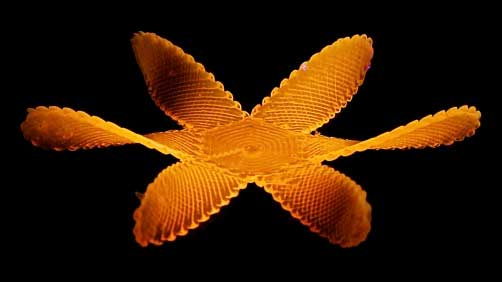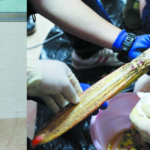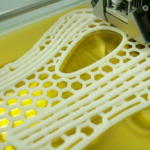

A team of materials science and engineering researchers from UC San Diego (UCSD) closely studied the qualities of liquid crystal elastomers, or LCEs, in order to figure out how to make shape-shifting 3D printed structures out of the material. The results will lead to easier shape control, and manufacturing, of things like artificial muscles, soft robots, and wearable devices. Their inspiration for a material featuring varying degrees of actuation (ability to contract and degree of stiffness) came from real-life examples in the world around us, such as a squid’s beak, which is really stiff at the tip but more malleable and soft where it connects to the cephalopod’s mouth.
The team—Zijun Wang, Zhijian Wang, Yue Zheng, Qiguang He, Yang Wang, and Shengqiang Cai— published a paper about their research, titled “Three-dimensional printing of functionally graded liquid crystal elastomer,” in the journal Science Advances.
The abstract states, “As a promising actuating material, liquid crystal elastomer (LCE) has been intensively explored in building diverse active structures and devices. Recently, direct ink writing technique has been developed to print LCE structures with various geometries and actuation behaviors. Despite the advancement in printing LCE, it remains challenging to print three-dimensional (3D) LCE structures with graded properties. Here, we report a facile method to tailor both the actuation behavior and mechanical properties of printed LCE filaments by varying printing parameters. On the basis of the comprehensive processing-structure-property relationship, we propose a simple strategy to print functionally graded LCEs, which greatly increases the design space for creating active morphing structures.”
Both a core and a shell make up 3D printed LCE filament. In learning how to control its material properties, the researchers found that, post-print, the shell stiffens and cools down quickly, but it takes longer for the core to cool, so it remained pliant for longer periods of time.
Wang, the paper’s first author and a PhD student in Cai’s research group, explained, “3D-printing is a great tool to make so many different things–and it’s even better now that we can print structures that can contract and stiffen as desired under a certain stimuli, in this case, heat.”
The point is, the researchers figured out that LCE’s degree of actuation could be easily controlled through the print temperature, and that by exposing the material to heat, they could also control the stiffness of various areas in the same material. So by changing print parameters, especially temperature, they were able to tune the material’s mechanical properties: the higher the temperature, the higher the flexibility of LCE.
“By controlling printing parameters, such as printing temperature, nozzle size, and distance between the nozzle and build plate, we can print LCE filaments with tailorable properties including actuation strain, actuation stress, and mechanical stiffness,” the researchers wrote.

They used direct ink writing (DIW) to print an LCE disk at 104°F, and then placed it in hot water, which heated the disk up to 194°F and shifted into a conical shape. But, the researchers found that when heating up an LCE disk that included areas printed at different temperatures, it would deform in a different shape.
Cai, a professor in the Department of Mechanical and Aerospace Engineering at the UCSD Jacobs School of Engineering, stated, “Based on the relationship between the properties of LCE filament and printing parameters, it’s easy to construct structures with graded material properties.”
They also printed lattice structures, and structures with two LCE layers, each with different properties, to show that the material would then have even more degrees of actuation freedom. Additionally, hot water isn’t the only thing the researchers used to activate the material’s actuation: they also infused the LCE with heat-sensitive particles, or ones that could convert absorbed light into heat, such as graphene or black ink powder.
For the proof of concept, which consisted of using one ink to print an LCE tube that had been tuned during the print process, the team demonstrated how it would adhere longer to a rigid glass plate if it had been actuated in warmer temperatures, as opposed to a tube with “homogenous properties.”
“We further demonstrate mitigation of stress concentration near the interface between an actuatable LCE tube and a rigid glass plate through gradient printing,” they wrote.
This specific finding could help improve the fabrication of robotic grippers and feet.
After the researchers determine how to tune material properties more efficiently and accurately, they will then focus on modifying the LCE ink so 3D printed structures can be made that are reprogrammable, or even self-repairing.
(Source: Nanowerk News / Images: Zijun Wang, UCSD)
If you're looking to get architectural 3D animation in the USA, our service provides an exceptional way to bring your architectural concepts to life through dynamic, immersive visuals. Through our platform, you can easily request high-quality 3D animations that showcase your designs in motion, offering a detailed view of your project from multiple angles and perspectives. Whether it's for a real estate development, a commercial building, or an urban planning project, our expert team ensures that every detail is captured in a visually compelling animation.
Through our website, you can seamlessly get architectural 3D animation tailored to your project’s specific needs. With our help, you can offer potential clients or investors an engaging experience that goes beyond static images. By integrating CGI animations with real-world settings, lighting, and textures, our team creates a lifelike experience that allows your audience to interact with your project as though it were already built. This service is perfect for presenting complex designs in a clear, visually attractive way that stands out in the competitive architectural market.




